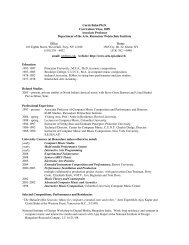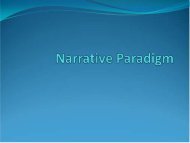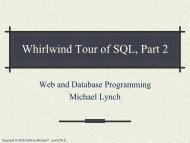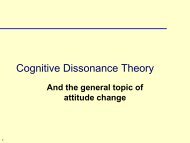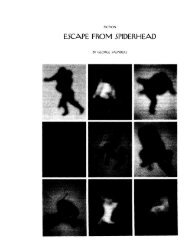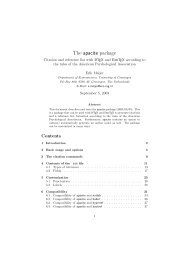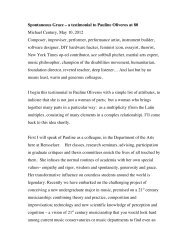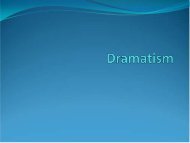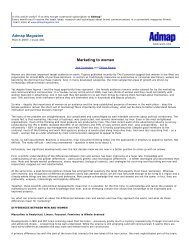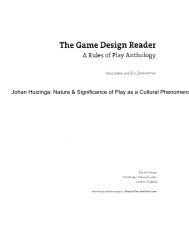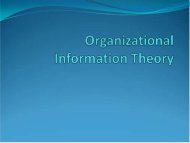The Game Design Document [.pdf]
The Game Design Document [.pdf]
The Game Design Document [.pdf]
You also want an ePaper? Increase the reach of your titles
YUMPU automatically turns print PDFs into web optimized ePapers that Google loves.
Heartland <strong>Game</strong> <strong>Design</strong> <strong>Document</strong><br />
Michael Pratt<br />
Experimental <strong>Game</strong> <strong>Design</strong><br />
Overview<br />
Heartland is an educational game designed to teach kids about agricultural, sustainable<br />
farming and how our actions can affect it. By going through the process of selecting,<br />
planting, raising, and harvesting a selection of crops, users learn not only how farming<br />
works but how important it is to everyone. By manipulating and balancing environmental<br />
and socio-political factors such as pests, irrigation, and pollution, the player learns more<br />
about how they interact to bring food to our tables.<br />
Artist's Statement<br />
I want to create this game because many kids don't know exactly where food comes<br />
from. A study in the UK showed that half of children aged 8 to 11 did not know that ham<br />
comes from pigs. This is troubling especially since when they grow up, policy decisions will<br />
have to be made about food, and if these children grow up with a lack of understanding<br />
about the basics of food, they may make decisions that cost them. This game aims to teach<br />
children the importance of food and how our decisions affect our ability to grow it. Children<br />
need to learn these topics in order to properly apply them when they are making policy in<br />
the future. I want a simple, fun, and easy educational game that will teach children about<br />
the basics of agriculture in a somewhat irreverent manner that I hope to be engaging and<br />
entertaining for kids. I chose the name Heartland precisely because it is so provocative and<br />
gives us images of the great American farming midwest, reminding us what we are trying to<br />
protect.<br />
<strong>The</strong>re are many controversial topics that can be covered in this game. To keep it simple<br />
and not to overwhelm the user too much, I have decided to keep the list of topics at clean<br />
versus dirty economics, sustainable farming, and governmental assistance. All of these<br />
topics are very important to farming and keeping food readily available yet even most<br />
adults do not know enough about them.<br />
<strong>The</strong> following is an example of how little many people know about agriculture.<br />
• Kids don't know where food comes from<br />
http://www.independent.co.uk/life-style/food-and-drink/news/kids-dont-know-theironions-about-food-674959.html<br />
Predecessors<br />
One of the first predecessors to come to mind is SimFarm, an older Sim game revolving<br />
around a farming community. This is the closest game I will come to emulating, with my<br />
game borrowing several concepts such as a town nearby to interact with. However, this<br />
game, like most Sim games, is very complicated and involves many non-linear factors that<br />
may be difficult to grasp for my targetted age group.
Another similar game along this genre is 3rd World Farmer. You control the lives of a<br />
family living in a 3rd world country, buying and planting crops and dealing with the realities<br />
of being able to send your children to school. While the game is fairly simple, I do not see it<br />
being engaging for young audiences, and deals with deeper social ills that may upset them.<br />
Additionally, I do not want this game to be moving kids toward foreign aid, but simply<br />
taking care of home first.<br />
Another Sim game that has a similar level and style of resource balancing is Sim Earth.<br />
While not nearly as complicated as replicating an entire planet, Heartland will borrow on the<br />
design that while individual factors can be directly manipulated, these manipulations have a<br />
cost and a drawback in that they also can throw other factors out of balance if you meddle<br />
too much in the wrong directions.<br />
Along the line of research, the following website by the United States Environmental<br />
Protection Agency has proven incredibly useful:<br />
http://www.epa.gov/oecaagct/ag101/crop.html<br />
<strong>The</strong> following sites have also contributed to research:<br />
• University of California Sustainable Agriculture Program<br />
http://www.sarep.ucdavis.edu/Concept.htm<br />
• Little Red Tractor - BBC Program teaching about different aspects of farms to young<br />
children<br />
http://www.bbc.co.uk/cbeebies/littleredtractor/<br />
Target Audience<br />
I am aiming this game towards grade-school age children, from 5-10, to be used in both<br />
a home and/or educational setting. <strong>The</strong> game is simple and self-explaining so as to allow<br />
children of varying educational levels to play it. <strong>The</strong>re will be no mathematics or<br />
memorization of complicated game mechanics as everything can be seen as simple benefit<br />
or detriment bars. <strong>The</strong> video clips explaining the mechanics of the game and real life will<br />
use simple terms anyone can understand while still conveying the necessary meaning.<br />
Introduction and Impact<br />
In this game, kids will control a small farm plot and manage simplified environmental<br />
factors such as rain and pests. Progressing through several different and increasingly<br />
complicated crops to grow, the children learn about what it takes to grow the fruits and<br />
vegetables that go onto their plates. I hope that these children will grow up knowing how<br />
important some of these factors like pollution and having enough land are, as we as a<br />
nation are beginning to clash when it comes to agricultural needs. Armed with a basic<br />
information of what plants need to grow and how humans can affect that, these kids can<br />
help shape policy for the better when their generation is in charge.<br />
Storyline<br />
<strong>The</strong> rough goal of the player is outlined by their mentor, a second farmer named Stan,<br />
characterized by a typical stocky, slightly overweight, plaid-and-overalls wearing man with a<br />
piece of straw hanging out of their mouth. Stan is an older, experienced farmer teaching the
player how to bring up different crops and wants to challenge them. <strong>The</strong> objective is to beat<br />
Stan's previous record in the country fair by producing bigger, better, juicier, etc. produce.<br />
To do that, you must make your crop grow perfectly, reducing factors such as birds (who<br />
may eat the crop), pollution (which makes it worth less, less tasty and such), and water<br />
(crops won't grow well with too much or too little water). A goal is set, the previous record,<br />
with the stakes being seeds for of Stan's other crops. In order to progress through the<br />
game, the player must be a better farmer than Stan and acquire his crops. <strong>The</strong> player's own<br />
records will stand in order for them to set and break their own former scores. <strong>The</strong> difficulty<br />
level determines how hard it is to bring the factors into balance and also how high the<br />
previous record is.<br />
Delivery System<br />
<strong>The</strong> game will be programmed in Python using the Py<strong>Game</strong> package. <strong>The</strong> game will be<br />
exclusively distributed over the internet with optional bundle to install Python and Pygame if<br />
the user does not have the interpreter.<br />
Interface<br />
Interaction with the game is meant to be simple. A isometric view of the world will show<br />
the farming area, simplified and scaled down in order to fit on one screen with no scrolling<br />
or other movement needed to see any part of your plot. Plants, trees, birds, pests, etc can<br />
all be seen in this main view. <strong>The</strong> main view will also display how well the environmental<br />
factors are doing: Too many pests will result in bugs appearing, too many birds and they<br />
will start to land on your crop.<br />
<strong>The</strong> player will be able to more accurately see each individual environmental factor in a<br />
bar along the left. A simple plus/minus/star system will represent how well the factor is<br />
being handled: Pluses mean you need more of that factor, minuses mean you need less,<br />
and up to three stars indicate how close to balanced the factor is. A tool bin next to the<br />
gauge allows the selection of tools to handle that environmental factor. For example, if<br />
there are too many pests, the player can click one of tool bin icons and activate a crop<br />
duster, which they can then direct with their mouse in order to cover the entire field. Money<br />
is, instead of a limited in-out factor in most games, a simple build up "power" factor to<br />
prevent the player from being able to just continually keep spraying pesticides and using<br />
irrigation, for example.<br />
Current crop yield and quality (score per yield) will be displayed as further gauges along<br />
the bottom left. <strong>The</strong> player starts off with no yield, a low quality crop, and a bit of money,<br />
which they must use to get their seedling crops above the ground. <strong>The</strong> player must continue<br />
to keep the crops in balance and quality high until harvest time, at which point the final<br />
score is taken and determined whether it beats last year's record.<br />
A secondary view will be of the nearby Town, in which players can help direct the politics<br />
and economics behind their farm. For example, they can at certain times request<br />
government money, which will allow the money factor to recharge faster, or lobby to keep<br />
major road projects away from the farm. <strong>The</strong>se concepts will be briefly explained by a<br />
narrator explaining the importance and will require little player involvement (simply
equesting roads stay away automatically grants it, for example) in order to show the user<br />
what happens but not require them to balance economic and socio-political issues as well as<br />
their own environment. <strong>The</strong> town will also serve as the menu in between games, with<br />
different buildings serving as menu options (Town hall changes player, or a road out of town<br />
quits the game, for example)<br />
User Interaction<br />
Most environmental factors will be activated by the user upon clicking the appropriate<br />
interface icon, which then changes their mouse cursor into the appropriate manipulator.<br />
Each factor will have a "basic" manipulator which costs very little money but does not have<br />
a huge effect on the crop, which is useful for the start of the level. <strong>The</strong>se manipulators will<br />
be held on the cursor and activated repeatedly or continuously, with each activation<br />
consuming money and affecting the crop without removing the tool. Examples of these tools<br />
will be a water nozzle, pest swatter, or the popular "Dog Bark" tool to scare away birds.<br />
Other tools, purchased later in the game, will be placed on the crop and work continuously<br />
for a short time, consuming money as they are placed and continuing to affect the crop until<br />
they disappear.<br />
To get to the town, there will be a picture of the town on the interface near the<br />
sunflower. Clicking that pauses the simulation and brings the user to the town. Different<br />
buildings will activate different features, for example, the town hall will allow the player to<br />
help pass or decline certain laws, and the bank will allow the player to apply for grants/<br />
loans. All these interfaces will be very simple and explained by the narrator when they first<br />
become available, and can be re-explained with a help button.<br />
Level <strong>Design</strong><br />
Levels will be designed based on the crop they are growing. Potatoes will be grown in a<br />
wide open field, corn and wheat will be grown in large circular fields, apples will be grown in<br />
rows of trees. <strong>The</strong> game will be roughly tile based, though the user themselves cannot<br />
select exactly how the tiles can grow. <strong>The</strong> tile growth and progression is determined by the<br />
environmental factors. If conditions are right for planting, a tilled tile may turn into a plant<br />
tile. If there are too many pests, tiles may start to exhibit insects. Tile growth parameters<br />
will be defined in the level file, with separate parameters describing each difficulty level.<br />
<strong>The</strong> Town<br />
<strong>The</strong> town will be the hub of all activity not related directly to the fields. It will consist of a<br />
few options to the player beyond the standard save, load, and exit. One simple option is to<br />
return to the fields. Another will be the town hall, where the player may lobby for or against<br />
policies that will affect their farm. Some policies will be outright beneficial or detrimental to<br />
the player and they must take the correct action to give them better or easier success.<br />
Other policies will be controversial and will both help and harm the player in different ways.<br />
It will be up to the player to determine which side they want to go with depending on their<br />
current situation. A short list of possible policies is below:<br />
Build a large commercial airport, increasing pollution significantly and allowing
cropdusters on demand.<br />
Build a small rural airport, increasing pollution slightly and allowing cropdusters, but less<br />
frequently.<br />
Create a city-wide composing initiative, reducing fertilizer costs.<br />
Require genetically modified foods to be marked, helping your final score if you are all<br />
natural but hurting it if you are not.<br />
Allow cloud seeding, costing money up front but increasing natural rain overall.<br />
Open lands initiative, increasing public open spaces. Increases bee and bird populations.<br />
<strong>The</strong> Environment<br />
Most of the game is about balancing environmental factors. A key component to this is<br />
that different factors will affect each other in unique ways that the players must learn.<br />
Below is a rough draft of the factors, how the player can manipulate them, and how they<br />
will interact with each other.<br />
Water: <strong>The</strong> most simple of the factors, the crop's water level will decrease over time,<br />
faster on sunny days. Water can be increased naturally through rain, or by the player<br />
activating a water nozzle or placing a water sprayer. Ideal water conditions depend on the<br />
crop. Water will decrease faster the more water there is, making it harder to maintain crops<br />
with high water demands.<br />
Pests: <strong>The</strong> bane of any crop, pests should be always kept at a minimum. <strong>The</strong> player can<br />
remove pests by swatting at them or placing a "Big Bag-o-Bugs" which will attract and kill<br />
the bugs. Pests reproduce exponentially, so they must be kept under control or their<br />
population can explode very fast.<br />
Birds: Certain crops don't mind birds, certain crops are eaten by birds. More birds can<br />
reduce pests, but will also reduce bees, and in the case of fruit crops, reduce the yield. Birds<br />
can be attracted to the area with bird houses, or driven away by dogs barking or a scare<br />
crow. <strong>The</strong>se are one time purchases from the town hall.<br />
Pollution: Pollution should be kept at minimal levels to increase crop yield and quality.<br />
Pollution will also drive away birds, pests, and bees. Pollution can be reduced by policies in<br />
the town hall, and by setting aside part of your land for a forest.<br />
Nutrients: Most crops must be continually fertilized, and each crop is different. Increasing<br />
fertilization will increase the yield, but it will also increase pollution and pests. Nutrients can<br />
be spread by a spreader truck throwing fertilizer or sprayed.<br />
Bees: Some crops need to be pollenated, and bees are the answer. Local bee population<br />
can be increased by policy in the town hall, setting aside part of your own land for a forest,<br />
or by hiring beekeepers to place hives. Bee populations are reduced by birds and pollution.<br />
<strong>The</strong> Crops and Difficulty Settings<br />
<strong>The</strong> following common, easily recognizable crops will be featured in the game, in order of<br />
difficulty and deliciousness. <strong>The</strong> crops were picked with the following criterion: Later crops<br />
should be roughly more difficult to grow, be more "interesting" or tasty, and operate on a<br />
seasonal basis. For this reason Apples was struck from the running as I could not figure a<br />
way to incorporate the trees already having been grown and decided the Apple level would
e boring. Note that the controls needed for each level do not match exactly with actual<br />
agricultural practices, but I tried to make them match as much as possible.<br />
Potatoes. <strong>The</strong> potato level will include water and pest control. This crop was chosen as a<br />
starter because it grows below ground and is very hardy.<br />
Wheat. <strong>The</strong> wheat level will require water and pest control, as well as introduce the policy<br />
decisions. Wheat will require slightly less water but be more sensitive to pests.<br />
Corn. This level requires a third control, birds. Corn will require moderate amounts of<br />
water, be about as sensitive to pests, but very sensitive to birds.<br />
Tomates. This crop will require a fourth, fertilization. Tomatoes require quite a bit of<br />
water and fertilization.<br />
Pumpkin. This crop requires a fifth, pollenation. Pumpkins require lots of water and<br />
fertilization. While not strictly as large scale of an agricultural crop as the rest, pumpkins<br />
still are grown and harvested. This crop and the next also act as rewards, being more<br />
"interesting" than the others.<br />
Strawberries. This final crop introduces no new requirements but each requirement<br />
affects the yield and quality more due to the delicate nature of the plants. Lack of water,<br />
too many birds or pests, all can devastate the crop yield.<br />
<strong>The</strong>re will be three difficulty settings. Easy, Medium, and Hard. Easy mode is as above,<br />
with a maximum of five factors to balance. Medium mode introduces pollution to every<br />
level, with each level being more sensitive to the pollution. Hard mode introduces no more<br />
factors but each factor affects the yield, quality, and each other more.<br />
Music and Sound<br />
Sound will be whimsical and fun, not necessarially realistic. Some sound effects may<br />
roughly be based on noises made by kids when playing with toy tractors rather than the<br />
noises a tractor would actually make when tilling a field. Music will be upbeat, not too fast<br />
but not too slow, in a jaunty but simple tone.<br />
Art <strong>Design</strong><br />
<strong>The</strong> art of the game will be simple and clean-looking hand drawn and colored art. <strong>The</strong><br />
crops will be personified, with facial features such as eyes and sometimes mouths.<br />
Machinery will be simplified and brightly colored. <strong>The</strong> only human, Stan, will have<br />
exaggerated proportions, with a large head, hands and feet. If time permits, I would like to<br />
animate the crops and the narrator flower to "dance" to the beat of the music, though this<br />
will be a low priority. All art will have the same flat, cartoon, outlined style to maintain a<br />
simple theme throughout the game.<br />
Rules, <strong>Game</strong>play, Scoring<br />
<strong>The</strong> game cannot be completely lost, keeping with a traditional supportive structure for<br />
education and children's games. In order to progress to the next level, the current crop<br />
must provide a certain amount of "yield" for the season. Below this amount and the player<br />
must redo the current level. <strong>The</strong> player increases their yield by keeping environmental
factors in balance. <strong>The</strong> closer they are to being balanced, the faster yield increases. If the<br />
environment is completely out of whack, the yield may decrease in harder difficulty levels<br />
due to rot or infestation. Instead of fighting to beat a level, in this game it is simply an<br />
attempt to beat it more efficiently, with higher yield, and a shorter time.<br />
Three factors are used to calculate the final score: Quality of the product, which is<br />
affected by how much pollution there was and whether or not the product was genetically<br />
engineered. Quantity of the product, which is the yield of the season and is affected by how<br />
well the factors were balanced. Asking for more money will decrease the end score, but only<br />
by enough to keep players from abusing the feature. Stan has kept his eyes on you and will<br />
judge the player and decrease the score accordingly if they used gene-modified seeds or<br />
asked for too much money.<br />
Once the final scoring has occurred, the record is either broken or not. If the record was<br />
not broken, the player can try again. If it is broken, Stan gives the player the seeds,<br />
unlocking the next level and allowing the player to continue.<br />
A few other "fun" statistics that have no other effect on the game are tracked and<br />
displayed at harvest time. For example, the game will keep track of how many bugs you<br />
squished, how many birds you barked at, and how much water you sprayed.<br />
Program Structure<br />
Two main game states: In town and in the field. In town can be as the main menu out of<br />
game or as part of a current game once a game has been reloaded. In the town, the<br />
simulation is paused. In the field unpauses the game and allows the player to manipulate<br />
the various factors.<br />
Each game state will be kept separate by the game and held open but hidden as long as<br />
the game is still running. <strong>The</strong> field game state will be loaded and modified when the levels<br />
change, whereas the town state will largely be kept around as it is the menu and is loaded<br />
from the start. If the player has not yet loaded a game, certain in-game functions (namely<br />
the ability to go to the fields) will not be active.<br />
During the game in both the town and fields, at certain times a secondary window may<br />
have to pop up, for example to show an instructional movie or to allow the player to choose<br />
field locations. Whenever another window pops up the game is paused (if it is not already),<br />
the rest of the screen around the window is tinted to emphasize the window, and the player<br />
may concentrate freely on the window. Once the window is gone (either due to being over,<br />
like for a movie, or the user has finished with it, if they selected a location) then the game<br />
resumes back to what it was doing before.


![The Game Design Document [.pdf]](https://img.yumpu.com/30117124/1/500x640/the-game-design-document-pdf.jpg)
